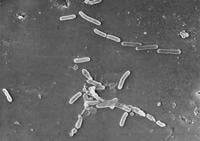NEW YORK (AP) — The patients' eyes were painfully inflamed. They could sense light but could see almost nothing else. A doctor called one case the worst eye infection he’d ever seen.
It was the beginning of a national outbreak caused by an extremely worrisome bacteria — one that some say heralds an era in which antibiotics no longer work and seemingly routine infections get horribly out of hand.
At last count, 58 Americans in 13 states have been infected, including at least one who died and at least five who suffered permanent vision loss. All have been linked to tainted eyedrops, leading to a .
Experts marvel at how disease detectives pieced together the case: Patients were scattered across the country. The illnesses occurred over the span of months. The infections were found in different parts of the body — in the blood of some patients, in the lungs of others.
But scientists also shudder, because they have long worried common bacteria will evolve so that .
"This really shows us that it's not something theoretical and in the future. It's here,” said Dr. Luis Ostrosky, an infectious diseases expert at the University of Texas Health Science Center at Houston.
This account is drawn from phone and email interviews with U.S. disease investigators, health officials in three states and regulators in the U.S. and India.
___
The investigation started in May in Los Angeles County, California. A patient who'd recently been to an ophthalmologist came in with a bad eye infection. A month later, local health officials got a second report. Another bad eye infection, same eye doctor.
Two more cases were reported in the county before the summer was over. The patients’ eyes were inflamed with heavy yellow pus that obscured most of the pupil. Among the four, two had complete vision loss in the affected eye.
The hospital that reported the first infection determined it was caused by a bacteria called Pseudomonas aeruginosa. The institution, which was equipped to do advanced genetic testing, quickly realized the bacteria had a rare gene that protected it from the effects of commonly used antibiotics.
It was an early break for investigators, said Kelsey OYong, of the Los Angeles County Department of Public Health.
OYong and her colleagues knew they were dealing with a scary germ, and they notified the Centers for Disease Control and Prevention.
Pseudomonas infections are not new. Drug-resistant strains of the bacteria cause more than 30,000 infections annually among hospitalized patients in the U.S. and more than 2,500 deaths, the CDC said. It can spread through contaminated hands or medical equipment, and is particularly dangerous to fragile patients who have catheters or are on breathing machines.
But the California infections were in patients' eyes, not more common spots like the blood and lungs. Also, the lab analysis determined the infections were caused by a Pseudomonas germ that could resist just about every antibiotic.
The only thing that worked was a newer antibiotic called cefiderocol, administered by IV.
___
Over the summer, Pseudomonas outbreaks were seen at long-term care facilities in two other states.
In Connecticut, the first case was in June. Eventually, the bacteria was found in 25 patients from five nursing homes in different parts of the state, said Christopher Boyle, a spokesperson for Connecticut’s health department.
In Davis County, Utah, north of Salt Lake City, the first of six cases was reported to the CDC in August. While the patients had the bacteria, none actually got sick, said Sarah Willardson of the Davis County Health Department.
L.A. County health investigators thought the cases there might be due to some kind of equipment contamination at the eye doctor’s office.
But that suspicion faded in early October, when genetic testing showed the clusters in California, Connecticut and Utah were all caused by the same bacteria strain — a version of the germ that hadn’t been seen anywhere before.
“That made us start thinking that this was some kind of a product,” said Maroya Walters, the CDC official supervising the investigation.
___
As the year went on, other reports of drug-resistant Pseudomonas came in, including a Washington man who died with a bloodstream infection.
Given the initial cluster at the California ophthalmologist’s office, investigators suspected an eye care product was the culprit, though that hypothesis was complicated by the fact that the infections at the long-term care facilities were mainly found in the lungs.
But it wasn’t impossible. Tear ducts drain into the nasal cavity, which leads to the lungs and could provide a path to deep inside the body.
In early November, investigators determined most of the infected Connecticut patients had been given artificial tears, though it wasn't clear who had been given which brand.
Then, on Nov. 9, a Florida hospital contacted the CDC to report bad eye infections connected to an outpatient clinic. A check of artificial tears brands used in Connecticut, Florida and Utah pointed to one common product: EzriCare Artificial Tears, an over-the-counter product marketed in the U.S. by New Jersey-based EzriCare LLC and made in India by Global Pharma Healthcare.
___
The Pseudomonas bacteria is “pretty much everywhere” in India and the drug-resistant germ is common in many hospitals, said Dr. Gagandeep Kang, who studies microbes in the Christian Medical College in the same state as Global Pharma's factory.
In January, genetic sequencing confirmed the Florida cases were caused by the same bacteria strain as the clusters in California, Connecticut and Utah. On Jan. 20, the CDC urged doctors to avoid recommending the EzriCare product.
There was no recall or widespread public notice, however. Investigators had strong circumstantial evidence pointing toward the EzriCare drops, but didn’t get more conclusive proof until more than a week later after testing found the bacteria in seven open bottles of EzriCare Artificial Tears in Connecticut and New Jersey.
In early February, CDC officials issued a public health alert and the FDA recalled the EzriCare eyedrops and Delsam Pharma’s Artificial Tears, another product made by Global Pharma. Last week, the recall was expanded to include Delsam Pharma’s Artificial Eye Ointment.
Global Pharma didn't respond to emailed requests for comment.
___
A month before the first recall, the FDA blocked imports of Global Pharma products.
FDA spokesperson Audra Harrison said the U.S. import ban was “unrelated to the outbreak," and was instead based on the company’s “inadequate response” to a records request and problems with its manufacturing procedures. She wouldn't say what those problems were.
The subsequent recall, she said, was recommended due to lack of microbial testing and issues with the product’s formulation and packaging.
The FDA, tasked with assuring the safety of drug products shipped to the U.S., has long struggled to inspect facilities in China and India that account for the vast majority of raw materials used in American medicines. A search of FDA’s online inspection database shows no records of agency staff visiting the plant.
Indian drug inspectors visited the plant and the country's drug controller asked Global Pharma to stop making all products related to treating eye disorders until they finish their investigation, said P.V. Vijayalakshmi, the drug controller for southern Tamil Nadu state.
___
Ostrosky, the University of Texas expert, called the U.S. investigation “a public health victory” saying it shows that fighting drug-resistant bacteria requires international collaboration and investment. But he also said the case is disheartening.
An infection that's usually easy to treat with common antibiotic eyedrops "has become an infection that can be deadly and has pretty much no treatment except one IV antibiotic,” he said.
Pseudomonas now joins a growing list of bugs — including bacteria that cause urinary tract infections — that are getting increasingly difficult to treat, Ostrosky added.
“It's like a wave coming for us," he said.
___
AP writers Matthew Perrone in Washington and Aniruddha Ghosal in New Delhi contributed.
___
The Associated Press Health and Science Department receives support from the Howard Hughes Medical Institute’s Science and Educational Media Group. The AP is solely responsible for all content.








































